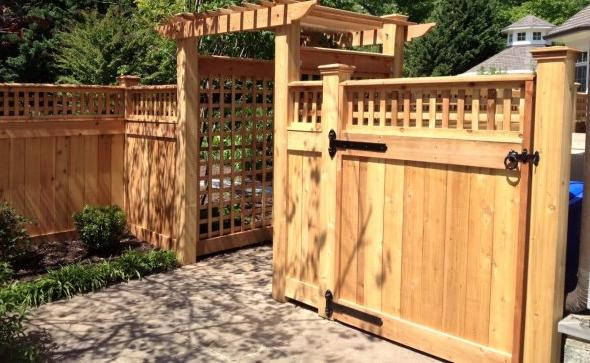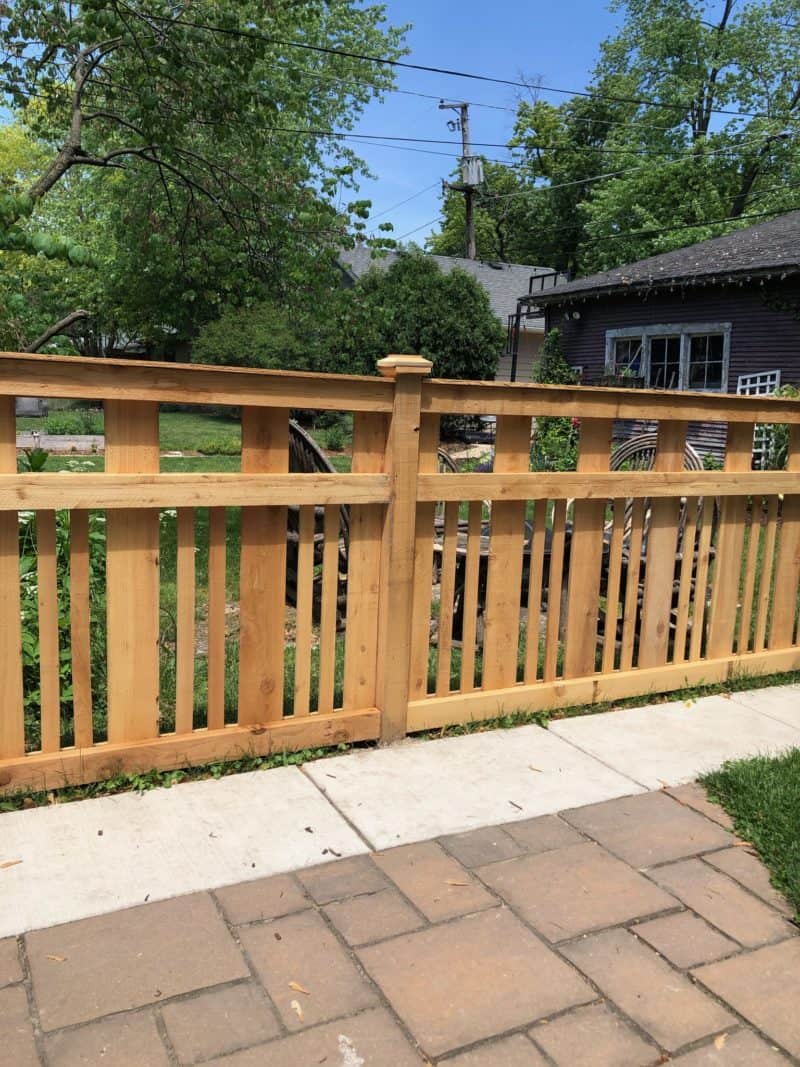All Categories
Featured
Your fencing is one of one of the most reviewed elements of your property, continuously dealing with the difficulties of altering weather. Whether it's solid winds, hefty rainfall, or severe warmth, climate can trigger substantial damage to your fence, resulting in expensive repair work or perhaps a complete replacement. The good news is, there are a number of approaches you can apply to safeguard your fencing and expand its life expectancy. Below are some sensible tips to secure your fence from weather-related damages.
Plastic Secure Fencing: Vinyl is immune and highly sturdy to dampness, decomposing, and bending. It likewise calls for little maintenance and can hold up against severe weather problems without fading or cracking. Metal Fencing: Wrought iron or aluminum fences are solid and durable versus wind and rainfall. They are susceptible to corrosion over time if not appropriately shielded. Applying a rust-resistant finish can aid protect their appearance and stability. Composite Secure Fencing: Made from a mix of timber fibers and plastic, composite fencings combine the most effective qualities of both products. They're resistant to decay, pest, and rot damage while supplying the look of natural timber. By choosing the ideal product, you can guarantee that your fence is better furnished to withstand the components.
Dampness Security: Sealants develop a water-proof barrier, preventing rainfall from leaking into the wood and creating rot or mold. UV Security: Sealants and stains obstruct UV rays, which can dry and tarnish the timber. Maintain Look: Routinely applying a safety surface will certainly keep the fencing's natural charm and avoid staining or fading. To make sure durable protection, reapply sealer or stain each to two years, depending upon your environment and fence wear.
![]()
![]()
Furthermore, cleansing your fence can aid get rid of dirt, mold, and particles that can create long-term damages. For wood fencings, delicately stress clean the surface to get rid of crud, while plastic fencings can be cleaned with a light cleaning agent option.
Final thought. Whether you're choosing the ideal materials, using protective layers, or strengthening blog posts, these easy techniques can aid shield your fence from the elements, saving you cash and extending the lifespan of your fence for years to come. Routine inspections and maintenance are crucial to catching issues early, so be certain to remain on top of your fencing's treatment throughout the seasons.
- Choose Weather-Resistant Products. One of the primary steps in protecting your fencing from weather-related damage is picking the appropriate product. Some products are normally more immune to the components, lowering the need for continuous repair services. :
Plastic Secure Fencing: Vinyl is immune and highly sturdy to dampness, decomposing, and bending. It likewise calls for little maintenance and can hold up against severe weather problems without fading or cracking. Metal Fencing: Wrought iron or aluminum fences are solid and durable versus wind and rainfall. They are susceptible to corrosion over time if not appropriately shielded. Applying a rust-resistant finish can aid protect their appearance and stability. Composite Secure Fencing: Made from a mix of timber fibers and plastic, composite fencings combine the most effective qualities of both products. They're resistant to decay, pest, and rot damage while supplying the look of natural timber. By choosing the ideal product, you can guarantee that your fence is better furnished to withstand the components.
- Protect Wooden Fencings with Discolorations and sealers. Wood fences are especially prone to moisture, UV rays, and severe temperatures. To secure your wood fence from these problems, using a high-grade wood sealer or stain is vital.
Dampness Security: Sealants develop a water-proof barrier, preventing rainfall from leaking into the wood and creating rot or mold. UV Security: Sealants and stains obstruct UV rays, which can dry and tarnish the timber. Maintain Look: Routinely applying a safety surface will certainly keep the fencing's natural charm and avoid staining or fading. To make sure durable protection, reapply sealer or stain each to two years, depending upon your environment and fence wear.

- Strengthen the Fencing Posts. To stop this, think about strengthening your fence messages by setting up concrete grounds or using more powerful products for message anchors. If you live in a location with heavy winds or seasonal frost, this included stability will certainly help safeguard your fencing from damage.
- Cut Surrounding Vegetation. Tree branches and vines growing near or over your fencing can create considerable damage in stormy weather. Not just will this secure your fencing, however it will certainly likewise enhance the total appearance of your backyard.
- Usage Windbreaks. Wind is a major element in weather-related fencing damage. Strong gusts can compromise or perhaps fall fencings, specifically if they're high or not effectively reinforced. One method to minimize wind impact is by mounting a windbreak. This can be as basic as growing bushes or trees near your fence or establishing a mesh screen. A windbreak acts as a barrier that lowers the direct influence of wind on the fence, stopping damage from high winds and gusts.

- Address Drainage Issues. Poor drainage is a significant factor to fencing damages, specifically for wood fencings. Water that accumulates around the base of fencing posts can trigger them to rot with time. Make sure that the ground around your fence has correct water drainage so water does not pool and trigger degeneration. Setting up a French drainpipe or including crushed rock around the base of the blog posts can aid direct water far from the fence. This simple fix can make a massive distinction in stopping moisture damage and protecting your fencing.
- Regular Evaluations and Maintenance. Regular upkeep is critical for shielding your fencing from weather condition damages. Check your fencing consistently, particularly after severe weather occasions, to determine any type of indications of damages. Try to find loosened boards, leaning articles, or corrosion on metal components. Catching little troubles early can prevent them from becoming bigger, much more expensive repairs.
Furthermore, cleansing your fence can aid get rid of dirt, mold, and particles that can create long-term damages. For wood fencings, delicately stress clean the surface to get rid of crud, while plastic fencings can be cleaned with a light cleaning agent option.
- Apply a Rust-Resistant Coating to Metal Fencings. Steel fences, especially those made of iron or steel, are susceptible to corrosion when subjected to dampness and humidity. To secure your steel fencing from corrosion, use a rust-resistant covering or paint.
Final thought. Whether you're choosing the ideal materials, using protective layers, or strengthening blog posts, these easy techniques can aid shield your fence from the elements, saving you cash and extending the lifespan of your fence for years to come. Routine inspections and maintenance are crucial to catching issues early, so be certain to remain on top of your fencing's treatment throughout the seasons.
Latest Posts
Reasons Routine Car Maintenance at Montclare Auto Repair Keeps Your Wallet Happy
Published May 27, 25
1 min read
Find Out Save Big on Car Maintenance with Montclare Auto Repair’s Limited-Time Deals
Published May 25, 25
1 min read
Uncover Save Big on Car Maintenance with Montclare Auto Repair’s Limited-Time Deals
Published May 24, 25
1 min read
More
Latest Posts
Reasons Routine Car Maintenance at Montclare Auto Repair Keeps Your Wallet Happy
Published May 27, 25
1 min read
Find Out Save Big on Car Maintenance with Montclare Auto Repair’s Limited-Time Deals
Published May 25, 25
1 min read
Uncover Save Big on Car Maintenance with Montclare Auto Repair’s Limited-Time Deals
Published May 24, 25
1 min read